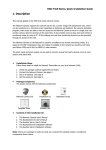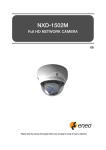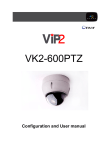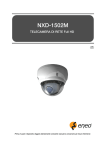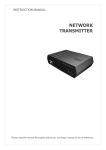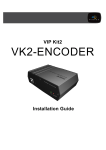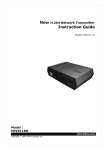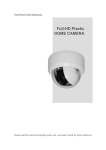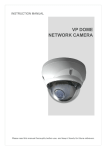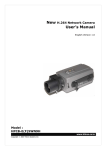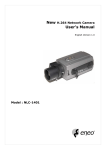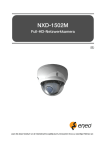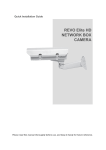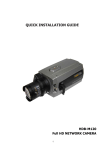Download New H.264 Network Camera Installation Guide
Transcript
New H.264 Network Camera Installation Guide English Version 1.0 Copyright ⓒ 2007 1. Product Description This manual applies to the Network Camera. The Network Camera supports the network service for an existing analog camera. An analog image entered can be monitored on a real-time screen regardless of distances and locations. By using its dedicated program, many users are able to have an access to the Network Camera at once or a single user can monitor various network cameras at the same time. It also enables users to play, store and retrieve a monitoring image by using a PC. All the settings and real-time monitoring screens are also provided through an access to the web. The Network Camera is a one-port video Camera including two-way audio, fully featured for security surveillance and remote monitoring needs. It is based on the DSP compression chip, and can digitize one analog video source and make it available on the network as real-time, full frame rate Motion JPEG and H.264 (or MPEG-4) video streams. The alarm input and alarm output can be used to connect various third party devices, such as, door sensors and alarm bells. Installation Steps Follow these steps to install the Network Transmitter on your local network (LAN): 1. 2. 3. 4. Check the package contents against the list below. Connect the Network Camera. See page 4. Set an IP address. See page 5. Set the password. See page 6. Package Components The system comes with the following components: Network Camera unit Installation CD Contents in the installation CD 1. 2. 3. 4. 5. The The The The The Network Camera User’s Manual NautilusClient16 User’s Manual Nautilus Server User’s Manual NautilusClient16 Installation software Nautilus Server Installation software 2 Installation Guide • Front View NO 1 2 3 Function Focus adjusting fixing screw Auto IRIS lens connector Setup Buttons • Rear View NO 2 3 Power Indicator Status Indicator 4 Video Out 5 6 6pin Terminal I/O Reset Button Description Connects the supplied power adapter or an external power supply 12V DC or 24V AC, max. 6.5Watt. Connects PTZ or PT device. Indicates power input. Indicates camera status. Connects the video output. This BNC connector provides a 1.0Vp-p/75 ohms composite video signal. Connects alarm In/Out, audio In/Out. Executes the factory default. 7 Network connector (PoE) RJ-45 port compatible with 10/100Mbps, which have a PoE function. 1 Function Power adaptor terminal RS485 terminal 3 LED Indicators LED Color Indication Steady for connection to a 100 Mbit/s network. Flashes for Green network activity. Network Steady for connection to 10 Mbit/s network. Flashes for Amber network activity. Unlit No network connection. Status Red Steady red for failed upgrade or booting. Steady green for normal operation or booting. Power Green Flashes green during firmware upgrade. Note: Steady green and red during booting. Flash green and red during factory default. 2. Installation For the operation of the Network Camera, it is necessary to connect a network cable for data transmission, power connection from supplied power adapter and connect a general analog camera. Depending on operation methods, it is possible to connect an alarm cable or audio cable additionally. For its fixation on different locations, please consult with an installer. Network Connection The Network Camera supports the operation through the network. Therefore, it is necessary to connect a standard RJ-45 cable to it. Generally a cross-over cable is used for directly connection to PC, while a direct cable is used for connection to a hub. IP Assignment When a camera, Encoder or Decoder is first connected to the network it has no IP address. So, it is necessary to allocate an IP address to the device with the “Smart Manager” utility on the CD. 1. Connect the Network Camera / device to the network and power up. 2. Start SmartManager utility ( All Programs> NautilusClient16 > SmartManager), the main window will be displayed, after a short while any network devices connected to the network will be displayed in the list. 4 3. Select the camera on the list and click right button of the mouse. You can see the popup menu as below. 4. Select Assign IP. You cam see an Assign IP window. Enter the required IP address. Note: For more information, refer to the Smart Manger User’s Manual. 3. Operation The Network Camera can be used with Windows operating system and browsers. The recommended browsers are Internet Explorer, Safari, Firefox, Opera and Google Chrome with Windows. Notes: To view streaming video in Microsoft Internet Explorer, set your browser to allow ActiveX controls. 3.1 Access from a browser 1. Start a browser (Internet Explorer). 2. Enter the IP address or host name of the Network Camera in the Location/Address field of your browser. 3. You can see a starting page. Click Live View or Setup to enter web page. 5 4. The encoder’s Live View page appears in your browser. 3.2. Access from the internet Access from the internet once connected, the Network Camera is accessible on your local network (LAN). To access the video encoder from the Internet you must configure your broadband router to allow incoming data traffic to the video encoder. To do this, enable the NAT-traversal feature, which will attempt to automatically configure the router to allow access to the video encoder. This is enabled from Setup > System > Network > NAT. For more information, please see NAT traversal (port mapping) for IPv4, on page 64, the User’s Manual. 3.3 Setting the administrator password To gain access to the product, the password for the default administrator user must be set. This is done in the “Admin Password” dialog, which is displayed when the network camera is accessed for the setup at the first time. Enter your admin name and password, set by the administrator. Note: The default administrator username and password is “admin”. If the password is lost, the Network Camera must be reset to the factory default settings. See page 9. 6 3.4 Live View Page The live view page comes in eight screen modes like 704x480(576), 704x240(288), 352x240(288), 176x120(144), 640x480, 320x240, and 160x120. Users are allowed to select the most suitable one out of those modes. Please, adjust the mode in accordance with your PC specifications and monitoring purposes. • General controls The video drop-down list allows you to select a customized or preprogrammed video stream on the live view page. The resolution drop-down list allows you to select the most suitable one out of video resolutions to be displayed on live view page. The protocol drop-down list allows you to select which combination of protocols and methods to use depends on your viewing requirements, and on the properties of your network. The preset drop-down list allows you to select the preset number for the PTZ camera being used. This icon is inactivated if the PTZ settings are not set. For more information, please see “3.4 Live View Page” on the User’s Manual. • Control toolbar The live viewer toolbar is available in the web browser page only. It displays the following buttons: The Stop button stops the video stream being played. The Pause button pause the video stream being played. The Snapshot button takes a snapshot of the current image. The digital zoom activates a zoom-in or zoom-out function for video image on the live screen. The Full Screen button causes the video image to fill the entire screen area. Press the 'Esc' button on keyboard to cancel full screen view. The Manual Trigger button activates a pop-up window to manually start or the event. 7 stop The Camera Menu button activates a pop-up window for camera menu control. The PTZ button activates a pop-up window for Pan, Tilt and Zoom control. Use this scale to control the volume of the speakers. Use this scale to control the volume of the microphone. Use this scale to control the volume of the speakers and microphones. • Camera Menu controls If the Network Camera has been appropriately configured, the Live View page displays the controls available for the OSD menu. For more information, please see “3.8 Camera Menu Control” on the User’s Manual. • Pan/Tilt/Zoom controls If the Network Camera has been appropriately configured, the Live View page displays the controls available for the PTZ(Pan Tilt Zoom) or PT device installed. The administrator can enable/disable the controls for specified users. Please see “3.9 PTZ Control” for more information. • Video and Audio Streams The video encoder provides several images and video stream formats. Your requirements and the properties of your network will determine the type you use. The Live View page in the video encoder provides access to H.264, MPEG-4 and Motion JPEG video streams, and to the list of available video streams. Other applications and clients can also access these video streams/images directly, without going via the Live View page. 3.5 Setup This section describes how to configure the network camera, and is intended for product Administrators, who have unrestricted access to all the Setup tools; and Operators, who have access to the settings for Basic, Live View, Video & Image, Audio, Event, and System Configuration. 8 You can configure the network camera by clicking Setup in the top right-hand corner of the Live View page. Click on this page to access the online help that explains the setup tools. When accessing the Network Camera for the first time, the “Admin Password” dialog appears. Enter your admin name and password, set by the administrator. If the password is lost, the video encoder must be reset to the factory default settings. See page 9. 3.6 Resetting to the factory default settings To reset the Network Camera to the original factory settings, go to the Setup>System >Maintenance web page (described in “3.6.6.6 Maintenance” of the User’s Manual) or use the control button on the network camera, as described below: Follow the instructions below to reset the Network Camera to the factory default settings using the Reset Button. 1. Switch off the Network Camera by disconnecting the power adapter. 2. Press and hold the Control Button with a straightened paperclip while reconnecting the power. 3. Keep the Control button pressed until the Status and Power indicator blink. 4. Release the Control Button. 5. When the Power Indicator changes to Green (may take up to 1 minute), the process is complete and the network video transmitter has been reset. 6. The transmitter resets to factory defaults and restarts after completing the factory reset. CAUTION: When performing a Factory Reset, you will lose any settings you have saved. 3.7 More Information For more information, please see the Network Camera User’s Manual, which is available on the CD included in this package. 9









